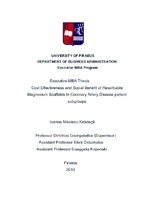Ανάλυση αποτελεσματικότητας του κόστους και του κοινωνικού οφέλους των βιοαποδομήσιμων ικριωμάτων μαγνησίου (RMS) σε υποομάδες ασθενών με στεφανιαία νόσο (CAD)
Cost effectiveness and social benefit of resorbable magnesium scaffolds in coronary artery disease patient subgroups

View/
Keywords
Cost effectiveness ; Social benefit ; Resorbable magnesium scaffolds ; Coronary artery diseaseAbstract
Economic crisis in Greece has caused a trauma to quality of life of the population. Due to austerity program, healthcare expenditure has been decreased and innovative technologies have limited access to the market. Innovative products are supposed to be costly. But are they? How can we claim that a technology is costly and in which way is it? If the criteria is just the product price, then of course, innovation is expensive. Still, if we compare the long-term benefits of innovative technologies to the initial cost, then the result may be the opposite. The aim of the current analysis is dual dimensional. Concerning the one dimension, we will explore if RMS might be cost effective and / or have social benefit in coronary artery disease subgroups of patients. Since we are not physicians and it is only them to identify the subgroups, we will have our estimations based on the Scientific Committee of the National Tender regarding the share of the scaffolds and on the fact that RMS have approximately zero scaffold thrombosis. We will estimate the indirect cost and its consequences on macro- and micro-economy based on PPYLL and DALYs. We will also estimate the direct cost by comparing the initial extra cost due to RMS use and the cost due to re-hospitalization and revascularization because of stent thrombosis and extension of dual antiplatelet therapy. With regard to the second dimension, we will explore coexistence of factors that may influence the technology price. By clarifying these factors and the way they affect to the product price and continuously to the budget, we will suggest alternative, non-costly approaches to the technology.
In order to conclude, Resorbable Magnesium Scaffolds technology seem to be cost effective and socially beneficial in patients with high risk of potential stent thrombosis, young patients and babies or children. Payment terms seem to be the key factor to achieve innovation embody to the market without increase of healthcare expenditure. Additionally, increase of budget leads to price decrease followed by increase of volume and number of patients who might have the benefits of the technology.


